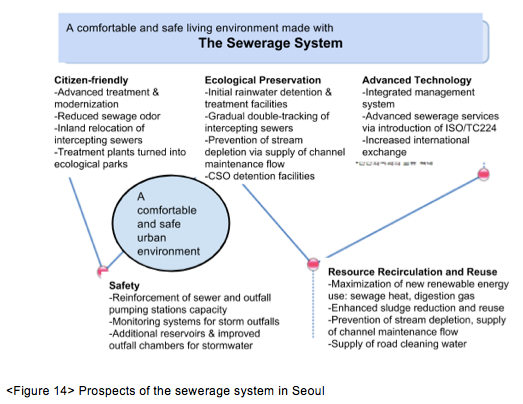Sewage: from Pouring to Processing
Water pollution and the aggravation of flood issues
Records dating from 1962 show that swimming was banned in the lower streams of Hangang-daegyo while deformed fish with crooked spines were reported, testifying to the severe water pollution in the Han River which Seoul, with a population approaching 3 million, was facing. In a 1963 survey, BOD values reached 241mg/L in Cheonggyecheon and 124mg/L in Jungnangcheon. In addition, the seasonal rains typical of the Korean climate were contributing to frequent flooding.
A need for sewage treatment in Seoul was further highlighted as the 1960s saw the beginning of an explosive population influx, and industrialization went into full swing in the 1970s. Modernized sewerage spread throughout Europe after the mid-19th century, as the dumping of human waste into streams along with other causes led to urban problems such as raging cholera epidemics; while Seoul did not experience the same problems, concerns nevertheless arose regarding similar risks.
Seoul's sewer system back then was rather incomplete, inclined towards flood-prevention measures such as rainwater exclusion. Under the circumstances, improvement of water quality in the Han River was prioritized, and large-capacity sewage treatment plants were constructed in a short period of time.
In Western Europe, sewers were first constructed to allow the complete discharge of sewage into streams, with sewage treatment plants built thereafter. Japan, launching its sewerage plans after Europe, reflected on its predecessor and simultaneously installed sewers and constructed sewage treatment plants. For its part, Seoul had sewage treatment plants built before an adequate sewer system was in place; therefore, the faulty wastewater inflow into those treatment plants meant that domestic sewage could not be sufficiently treated. Only after the entire sewerage system was developed, including sewer installation, did the city see significant improvements.
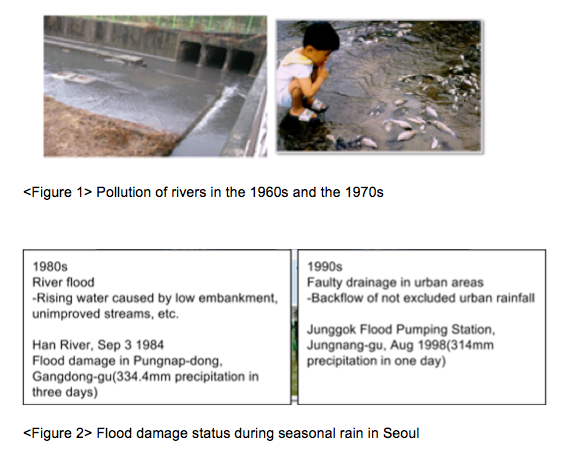
Because Korea traditionally used human waste as fertilizer, the pollution of rivers and the living environment caused by the dumping of human waste was relatively less intense.
Water quality of the Han River had become an urgent problem as the 1986 Asian Games and the 1988 Summer Olympics approached.
The construction of sewage treatment facilities and sewers
Expansion of sewage treatment facilities and improved eco-friendliness
The first sewage treatment plant: the city at 3 million in population
The first attempt to construct sewage treatment facilities in Seoul materialized in 1962. Since the country had neither the financial resources nor the technology to construct a large-scale sewage treatment facility, foreign credit was brought in: the project was funded through a loan from the US Agency for International Development (USAID) and led by Daniel, Mann, Johnson & Mendenhall (DMJM). The plan for Cheonggyecheon Sewage Treatment Project was devised in 1962; the loan request plan was submitted to the Ministry of Construction in 1964 and the government-guaranteed Loan Application was submitted to USOM/K in 1965. Following the Loan Guarantee passing the National Assembly in 1966, the USD 3.5 million AID loan agreement was signed in 1967, and in the same year, a technical service agreement was signed with DMJM. The project design was approved in 1969, and 1970 saw the construction initiated after the design approval by USAID. However, inflation led to a shortage of funds, and an agreement for an additional USD 2.8 million loan was signed in 1974. Construction was completed in 1976, six years after work had begun. With 14 years passing between planning of the first sewage treatment facility in Seoul and its completion, the city finally entered the age of modern sewage treatment.
Cheonggyecheon Sewage Treatment Plant (currently the Jungnang Water Reclamation Center, Plant No.1), with a capacity of 150,000 ㎥/day, was capable of processing domestic sewage generated by 1.3 million people in the 5,600ha Cheonggyecheon watershed area. The wastewater, with an average BOD of 330mg/L reached 19mg/L or less after treatment and was discharged into Jungnangcheon, before flowing into the Han River's mainstream.
The next facility to be constructed was Jungnangcheon Sewage Treatment Plant, for which ground was broken in 1975. Financed with KRW 4 billion in loans from the UK bank, Gradley Brandt, and KRW 6.2 billion in domestic loans, the budget totaled KRW 10.2 billion for a plant with a treatment capacity amounting to 210,000 ㎥/day. Unlike Cheonggyecheon Sewage Treatment Plant, the new plant featured a self-generating capacity of 1,400kW, 60 percent of its required electrical power, using gases produced during the treatment process.
Expansion of sewage treatment facilities
The Han River Development Project led to another series of comprehensive sewerage development projects. Under the agenda for an advanced capital and in preparation for the 1986 Asian Games and 1988 Summer Olympics in Seoul, the project had as its goal a comprehensive and multi-purpose development of the Han River. After launching in September 1982, the project involved 11 domestic construction companies and a total budget of KRW 413.3 billion.
The Han River Development Project was completed in September 1986. The urgency of conserving Han River water, increasingly recognized along the course of the project, resulted in establishment of the Sewer Maintenance Master Plan and construction of additional sewage treatment plants.
Measures were taken against rapid population growth and industrial development-induced water pollution into the Han River and bodies of water where discharge occurs such as Jungnangcheon and Tancheon. The Sewer Maintenance Master Plan devised in 1984, and the 1992 amendment, applied to the entire area of Seoul and included an objective for total sewage coverage by the year 2001.
<Table 1> 1992 Amendment to Seoul's Sewer Maintenance Master Plan (in brief)
| Target year |
Total population (1,000 people) |
Population connected to sewerage system (%) |
Total length of sewers (km) |
Maximum daily sewage emission (10,000 ㎥/day) |
Sewage process rate (%) |
|---|---|---|---|---|---|
| 2001 | 12,477 | 100 | 10,951 | 703 | 100 |
| 2011 | 13,358 | 100 | 11,700 | 772 | 100 |
In order for these plans to be realized, Seoul was divided into four treatment areas around the time of the 1988 Summer Olympics. Biological secondary treatment was assigned to plants corresponding to Jungnang and Tancheon areas, located upstream, and primary treatment was assigned to Gayang (currently Seonam Water Reclamation Center) and Nanji treatment plants, thereby truly bringing the city into the age of modern sewage treatment. Consistent facility expansion afterwards resulted in a total capacity of 3.71 million ㎥/day in December 1995 corresponding to 73 percent of total sewage quantity, and through another expansion initiated in 1998 aiming for complete sewage treatment, a capacity of 5.81 million ㎥/day was realized.

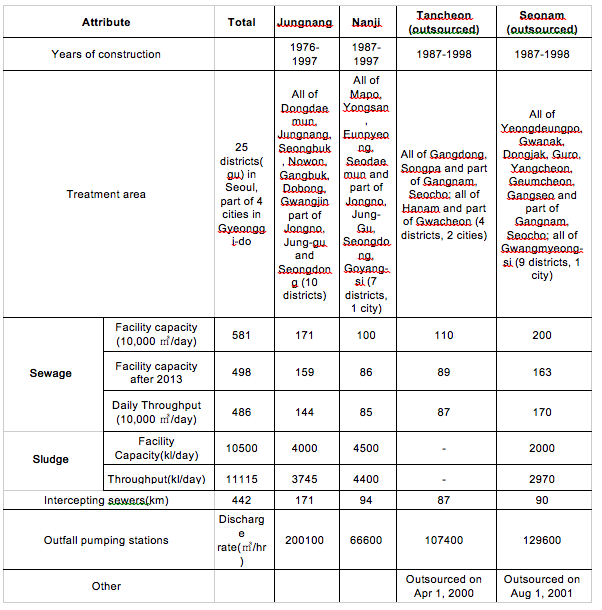
Greening of sewage treatment facilities
By covering the upper part of the water reclamation centers and turning those spaces into eco-friendly parks, the local population has been provided with resident-friendly rest and relaxation areas.
Improvement of sewers
Combined sewer system
Eighty-six percent of Seoul is serviced by combined sewers. Construction of such facilities in Seoul was initially planned for rapid exclusion of stormwater to prevent urban flooding, rather than the provision of infrastructure for the city's future development; therefore, sewer maintenance in frequently-flooded lowlands and areas with faulty drainage was a priority.
In addition, deterioration of the sewers resulted in problems such as damage and faulty connections, which in turn led to excessive inflow of groundwater, rainfall, river water, tap water and water from unidentified sources.
Due to the inflow of stormwater, groundwater and such, along with the quotidian sewage, the total inflow reaching treatment plants amounted to 5.09 million ㎥/day by 1995, overloading the total processable facility capacity of 3.71 million ㎥/day. Sewage exceeding facility capacity underwent only primary treatment and bypassed secondary treatment plants, inevitably being discharged with water undergoing the full treatment process and leading to serious water pollution issues in the areas of discharge.
Introduction of separate sewer systems
Since 1981, separate sewer systems have been introduced to newly-constructed areas. The construction aimed at economical and effective sewer maintenance to recover the functionality of deteriorated and faulty sewers, diminishing the inflow of unidentified water such as valley water or river water to reduce the load on sewage treatment plants, and ultimately allowing for the direct input of human waste into sewers.
Newly-developed large-scale residential zones including Sanggye, Junggye, Gaepo, Garak, Mokdong, Balsan and Godeok have separate sewers, which separately process sewage and stormwater. Of areas serviced by combined sewer systems, large apartment complexes adjacent to sewer treatment facilities and redevelopment areas are to some extent possible candidates for the transition to a separate sewer system. However, most roads in combined sewer areas are limited in breadth and also encumbered with other underground utilities. Therefore, a total transition to separate sewer systems is unrealistic.
A Sewer Rehabilitation Plan was devised that applied a combined exclusion process to existing urban areas and a separate exclusion process to newly developed areas. Wastewater generated in each area was carried through sewers installed along the Han River and its tributaries before entering sewage treatment plants where it was treated and discharged (effluent standard maintaining a BOD value of 3mg/L in the upper streams of Singok Submerged Weir).
Sewer maintenance for prevention of flooding
The average annual precipitation of Seoul over the past 50 years (1962-2011) amounts to 1,429.5mm; this average has increased in the past 10 years by 184.2mm over the first 10 years of record: from 1,498.4mm (1962-1971) to 1,613.7mm (2002-2011). In addition, while the average number of days with at least 80mm rainfall and the high potential incident rate from 1962 to 2011 was 3.0 days, the ten-year average over all decades showed an increase of 0.7 days and, therefore, an increase in flood damage after the city’s urbanization process, from 3.2 days in 1962-1971 to 3.9 days in 2002-2011.
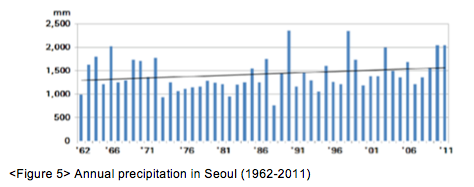
Facilities that make up a city's drainage system include embankments, gutters, sewers, detention basins, retention basins and drainage pumping stations. In the process of urbanization, existing natural streams are sometimes reduced or turned into culverts; as the extent of impermeable area had increased 40 percent by 2010 (compared to 1962), natural groundwater flow became fast-moving on the surface. Such a quantitative increase of surface overflow and the acceleration of peak flow velocity in turn increases peak runoff, resulting in stream depletion and shorter concentration time.
Towards reducing flood damage, the city of Seoul is undergoing sewer maintenance operations to resolve problems such as drainage system overload, lack of adequate catchment facilities, flooding of underground facilities such as the subway, faulty natural flow, and water level rise in rivers and basins. Retention basins and stormwater storage tanks are under construction as effective measures against exceptional situations when river flooding caused by water level rise coincides with urban flooding caused by localized heavy rains and faulty drainage of street water. In preparation against flood damage caused by localized heavy rains, the city extended in 2009 the standards for considering average probable rainfall, applying to its sewer system's stormwater exclusion capacity: from 10 years for main sewers and 5 years for branch sewers to 30 years for main sewers and 10 years for branch sewers.
A smart sewerage system using advanced information technology
Constant maintenance and enhancement of sewerage system efficiency are also important tasks, for which the city has introduced state-of-the-art information systems for better maintenance and enhancement of services to residents.
Achievements of sewerage improvement
Seoul currently boasts a 100 percent connection rate to the sewerage system and by the end of 2013 possessed sewage treatment facilities with a total capacity of 4.98 million m3/day. The total length of sewers by the end of 2012 amounted to 10,487 km.
Swimming in the Han River made possible through improvement of water quality
Seoul has currently achieved 100 percent connection of its population to the sewerage system. Total treatment capacity, originally 5.81 million ㎥/day, had reduced to 4.98 million m3/day by the end of 2013 after conversion to advanced treatment facilities with higher efficiency in nitrogen and phosphorus treatment. Total sewer length remains stable at 10,487 km. Introduction of advanced sewage treatment for nitrogen and phosphorus removal in 1996 has further improved water quality of the Han River; midstream and downstream BOD has been reduced to as low as 3mg/L or less, which makes swimming possible.
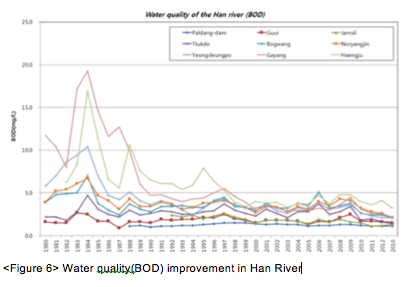
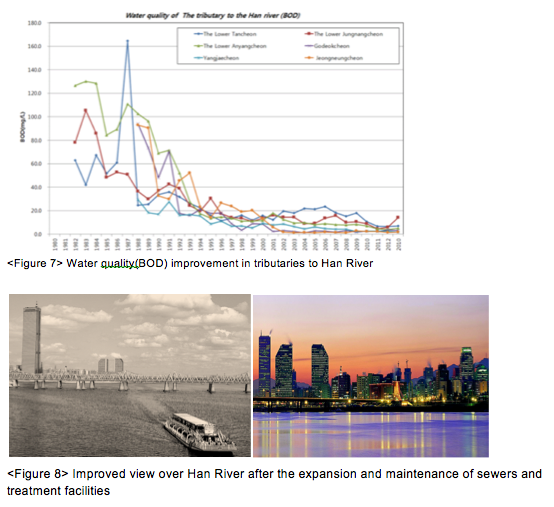
Improvement of water quality in tributaries
Water quality improvement in Jungnangcheon
Even after achieving 100 percent sewerage connectivity (population covered by sewage treatment facilities and sewers) in 1998, the water in Jungnangcheon remained quite contaminated with BOD values exceeding 20mg/L. Advanced treatment was introduced in 2011 to Jungnang Water Reclamation Center, resulting in much improved quality. Furthermore, as the area upstream of Jungnangcheon water system, such as Uijeongbu, reached 90 percent or more in sewerage-connection to population and introduced advanced sewage treatment facilities, the current BOD is a stable 10mg/L or less.
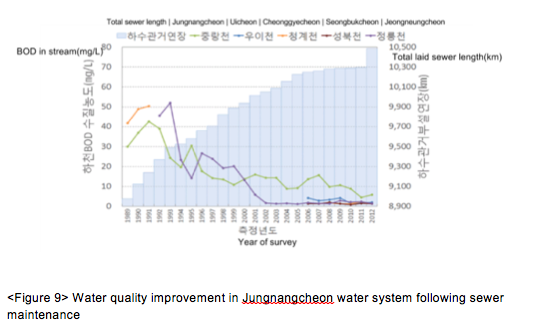
Improvement of water quality in Tancheon
Even after 100 percent sewerage connectivity in 1998, the water in Tancheon remained quite contaminated, with BOD values exceeding 20mg/L. As the area upstream of Tancheon water system, such as Seongnam, expanded its facility capacity and introduced advanced sewage treatment facilities, and advanced treatment was introduced in 2011 to Tancheon Water Reclamation Center, the water quality considerably improved, and BOD is a stable 10mg/L or less.
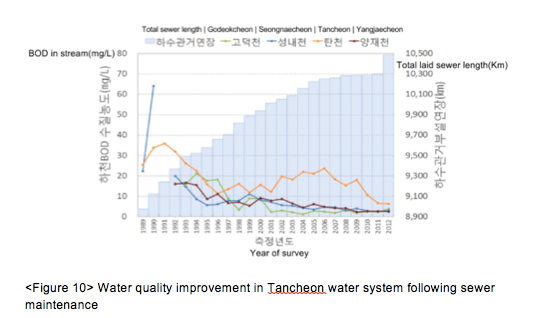
Comprehensive efforts to reduce flood damage during localized heavy rains
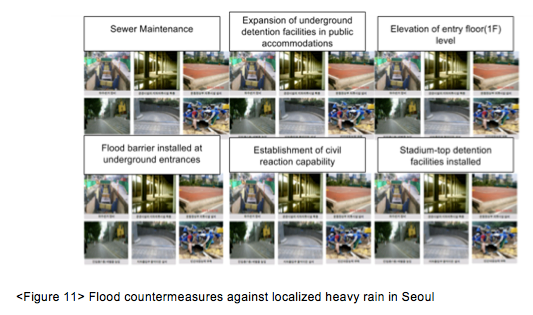
Organization of the sewerage management system
The four sewage treatment plants currently in use include Jungnang, Nanji, Tancheon and Seonam Water Reclamation Centers. “Sewage treatment plants” underwent official name changes to “water reclamation centers” in 2006, in an effort to rebrand the plants away from sounding like locally-undesirable facilities to needed water production facilities. Sewage treatment facilities were under direct municipal operation of the Seoul city government until the IMF financial crisis in 1997 led to a general restructuring of the government and the consequent restructuring of organizations affiliated with the city in 1999, resulting in a decision to gradually privatize sewage treatment plants. The Government Organization Act and the Act on Public-Private Partnerships in Infrastructure provided the legal grounds for such moves.
As part of its restructuring efforts, the Seoul Metropolitan Government has been holding discussions led by the Administrative Reform Committee and the Administrative Reform Working Committee on the reorganization of affiliated agencies, including the treatment plants, since 1998. Of the four water reclamation centers, Tancheon and Seonam were outsourced in 2000 and 2001, respectively. The decision to outsource Nanji Water Reclamation Center, based on the 2008 reorganization plan for the Establishment of Organizations with Efficiency and Competitiveness, which put emphasis on the active contracting-out of outsourceable facilities and efficiency of organizational management, eventually foundered. Consequently, Nanji and Jungnang were left under direct management and partial outsourcing contracts. In order to secure the financial resources for sewerage management, sewerage user fees have been collected since 1984 according to the “causer pays” principle.
The administrative organization supervising Seoul's sewerage facilities is led by the Water Quality Management Bureau under the Urban Safety Office, which directs a total of four divisions (each consisting of five or seven teams): Water Quality Management Division, Sewerage Treatment Planning Division, Sewerage Treatment Facilities Division and Stream Management Division. Of these, the Sewerage Treatment Planning Division and Sewerage Treatment Facilities Division are directly related to sewer management. Two of the four water reclamation centers, Jungnang and Nanji, are under direct municipal management with the exception of outsourced sludge treatment facilities, while Tancheon and Seonam Water
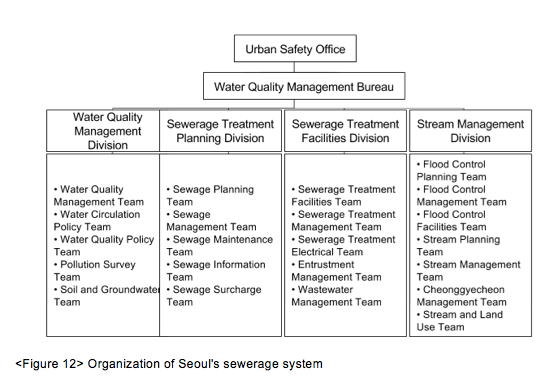
Difficulties
Significant precipitation differences throughout the year due to characteristics of the rainy season
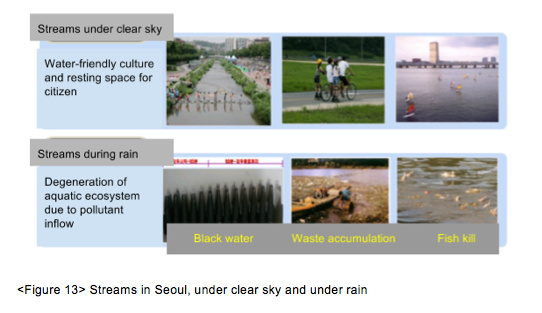
Lack of awareness and faulty construction of separate sewer systems
In order to prevent confusion or misconnection of sanitary and stormwater sewers in separate sewer areas, construction standards require the former to have a dark brown surface or dark brown tape or paint covering its upper part. Public awareness campaigns for residents towards correcting existing misconnections according to the “causer pays” principle have been unsuccessful despite 5-8 years of enforcement, due to practical difficulties.
Insufficient financial support for the sewerage system
Recent changes in climate have meant variation in rainfall characteristics, causing sewer flooding in urban areas of Seoul and, therefore, calling for continuous flood countermeasures such as capacity-increasing sewer maintenance projects and construction of sewage detention facilities. In addition, as government regulations are increasing regarding TMDL, total phosphorus, simple sewage treatment of discharged sewage untreated by public treatment facilities during rainfall, CSO countermeasures and such, water quality control at terminal disposal facilities is becoming a larger challenge.
Continuous investment of additional financial resources is needed to meet these requirements. However, instead, recent years have seen diminishing funds made available for sewerage facilities, making even the adequate maintenance of existing situations a difficult task.
Since current sewerage user fees are extremely low, falling short of actual treatment costs, some financial improvements may be possible to some extent through establishment of appropriate sewerage user fees. Towards this end, original assets need to be evaluated, total costs recalculated, and an independent sewerage budget established that will allow sewerage services to switch to a local public enterprise accounting, based on the Local Public Enterprises Act.
Conclusions and implications
There are 36 waterways running in or through the city of Seoul as defined by law, including the Han and five other rivers and an assortment of streams; water quality in these streams is maintained with the objective of enabling swimming, in order to provide citizens with ample water resources. Through past water quality management achievements, including a 100 percent sewerage-connected population and reduced water pollution, the pollution load flowing into rivers has diminished, and water quality has greatly improved.
The functions of a sewerage system include flood prevention via urban rainwater exclusion, sewage carrying, improvement of the living environment with flush toilets, water preservation in public bodies of water such as rivers, lakes and seas as well as protecting health and sanitation. As the sewerage system is an indispensable part of infrastructure in relation to people's environmental rights, the necessity for proper maintenance is ever increasing.
When considering the characteristics of runoff in Seoul, as an urban center, a dominance of impermeable area directly connected to the drainage system can be noticed, which, along with changes in rainfall patterns, influences the planning of urban drainage facilities. The close relationship sewage issues have to urban planning and land use must be taken into account. Long-term variations in rainfall patterns due to macroscopic changes such as climate change must also be prepared against in advance, to prevent disasters such as flooding.
With the objective of creating a comfortable and safe living environment, Seoul is proposing the next step in construction of a future-oriented sewerage system which features advanced technology and promotes citizen-friendliness, ecological preservation, security and resource recycling.
